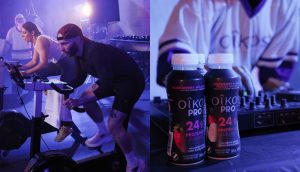Bill Buxton is the keynoter at tomorrow’s Canadian Media Directors Conference in Toronto. A principal researcher with Microsoft, he splits his time between Toronto and Seattle, but took a few minutes out to share his thoughts on how our interaction with media will grow ever closer, and much more subtle, in the years to come, and what that means for media agencies and marketers.
MiC: What excites you in the media universe today?
BB: It’s not really any single gadget; it’s more how the gadgets as a collection start to work together. It’s what I call the society of appliances. It means that instead of thinking of my mobile phone as distinct from that movie poster, when they’re beside each other, they can interact and connect, just by proximity. The best way to think about it is, if you have Bluetooth in your car and you get in with your mobile phone, it becomes part of the car and uses the mic and speakers built in the car, and so your car is now your phone. That kind of proximity-based behaviour is really interesting.
MiC: Do you think that relationship is only going to get closer?
BB: I think we’ll have more and more specialized, personalized gadgets in the same way now we have a watch, a digital camera, a phone and a GPS. But at the same time, there will be things embedded in the buildings where we work, shop and live that are stationary or fixed. Those two classes of devices are going to have quite a different relationship, and we’ll see growth in both spaces.
MiC: What are some of the things developing in your field that will contribute to the media world in the future and the situation you just described?
BB: Some of the most interesting things that are already appearing in limited numbers are things where, for example, instead of having a desktop computer, we’re making desktops and tabletops that are the computer. So the digital device is the furniture, or augments the functionality of existing furniture. In the old days, remember when Pacman was in bars and restaurants, and you could put your food or drink on what was essentially a table? And the game was built into that table? It’s kind of like that, only it’s not just Pacman, and it’s not something that’s restricted to a public bar because it’s so expensive. It might be that instead of your game table being folded up – like my parent’s card table – it might have the games embedded in it. It’s a whole new notion of a board game! The table is the board game.
MiC: As digital devices and humans get closer together, they’re being integrated into our lives in a fundamental way.
BB: Yes, and architecturally so. Most people, when they drive in a modern car and they go to stop, think they’re pushing on a brake pedal and activating the brakes, but in fact they’re pushing a mouse cleverly disguised as a brake pedal. That input is going to a computer that’s running software and the computer display, instead of being a flat panel on a laptop, is the calipers on the brake pad. And virtually nobody is, or should be, conscious that when they push on a brake pedal that they’re actually working on a computer, it’s just embedded in the system. But they will notice it when they have to brake in an Ontario winter, when they’re on ice, and they put on the brakes and the ABS kicks in and your 85-year-old grandmother can brake the same way that Michael Schumacher can in a F1 car.
So you don’t notice it unless you need it and it comes in quietly and appropriately. The fancy word for that is embedded computing. I think my job is to make computers and technology disappear. Ironically – and this is a paradox – there will be way more of them but they will be way less visible.
MiC: So, for media agencies, this is something they should be aware of and prepared for?
BB: Yes, absolutely. There’s one case I was involved in when we did a media buy, it was in Las Vegas for a big trade show, and we were buying for television, so your first thought is that you’ll be buying for cable TV, and it will appear in the hotels. Well in fact, because all of the taxi cabs in Las Vegas have televisions in the back, the media buy for television was actually for the taxis. And yes, it’s TV in one sense, but because it’s in a taxi cab and considering how long you’re in a taxi cab, it’s a very different beast. And understanding the subtleties of something like that is really important.
Another example is [subway posters]. In many cities now, those are all being replaced by projected images that are digital. The notion that those things will not only be electronic but will become interactive, so that if you like what you’re seeing you can pull out your phone and your phone will connect with that and you can grab something from it, is interesting. Though, you really need to understand that the nature of content that you would put on those projected screens, in terms of advertising or any other type of messaging is not the same thing as you would with a television ad. Been there done that, it doesn’t work! In Vienna and Stockholm, it’s unbelievable – when [the projections] first came out, people just thought they were like the TV sets in the lineup when you’re waiting in the supermarket. Wrong! You’re in a subway, not a supermarket, and people have really different agendas and purposes. You really have to understand content.
MiC: And interfaces and user experiences would play a big role in that…
BB: Yeah, absolutely – I kind of wrote the book on that [laughs]. That’s what all of this is about. If you’re talking about advertising or any other kind of information, you’re trying to engage the public, and the thing about electronic media compared to paper is the level of engagement of the experience. It doesn’t mean you don’t get engaged in a book on paper, but it’s a different type of engagement.
Because with a lot of media [development, people figure that] since it’s a computer behind it, it’s just a different location, so they carry with them all of the baggage for designing a web browser or something for a desktop. But you’re not on your desktop, and what works as a mobile phone for example is not a shrunken down version of your desktop. It’s a different beast and we have to understand the difference. It doesn’t matter if it’s running the same software, or the same program or on the same internet – it’s a different thing.























